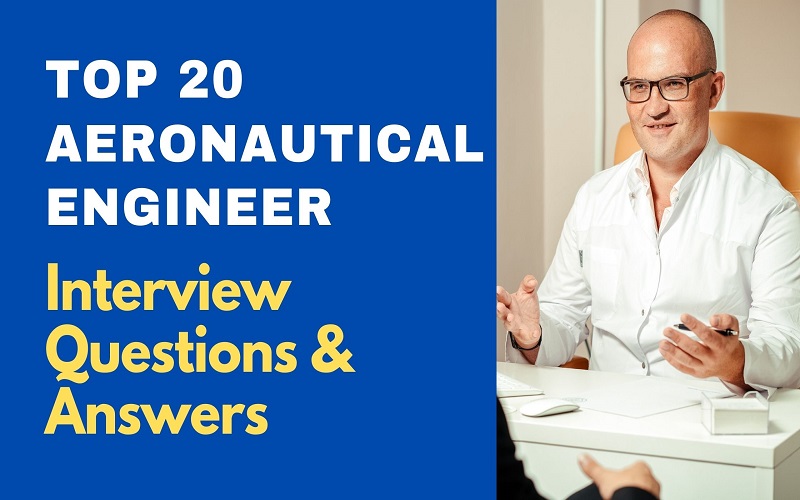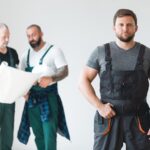Aeronautical engineers are also referred to as aerospace engineers. These individuals are primarily found in the aerospace, defense, and aviation industries, where they handle several projects. Mostly, they design, develop, research, and test challenging engineering solutions.
They have their fields of specialization and may also work with a team of other engineers to design electrical, propulsion, computer software, and structural systems. This article will look at some of the interview questions you should expect in an aeronautical engineering interview.
Remember to think through your answer and respond to questions boldly. The following are some of the most familiar aeronautical engineering questions:
1. Why Are You Interested in This Position?
This is usually one of the first questions in interviews. The interviewer will know if you are a good fit for the organization based on your answer. Remember, several people have applied for the same position, and the interviewer can use the simplest of questions to eliminate candidates. Therefore, sell yourself.
Sample Answer
I am an experienced aeronautical engineer with fifteen years of experience in this field. I have done all the roles captured in this job’s description, and therefore, I believe that I make an excellent addition to your workforce. Your company also has a superb reputation which I would like to be part of. Additionally, I grew up admiring your planes whenever we went on holiday with my parents and, therefore, it would be a pleasure to join you.
2. What Are the Roles of an Aeronautical Engineer?
This is one of the simplest questions in interviews. The interviewer wants to know if you understand this job’s description and what the company expects. Stick to the job description if one was provided or mention some of your mandated roles in your former workplace.
Sample Answer
Aeronautical engineers are mainly mandated to design and test aerospace products such as spacecrafts, aircraft, satellites, and missiles. They, therefore, create and test prototypes, check proposals, come up with design methods, and coordinate both design and manufacturing teams. They also inspect damaged products and assess different proposals.
3. What Are the Qualities That an Aeronautical Engineer Needs to Be Effective?
These first three questions are usually opening questions, asked to act as foundations for others. You definitely know some of the qualities required for aeronautical engineering. The best means to approach this question is to mention the qualities that have seen you through your career. However, make sure that they are specific to this role.
Sample Answer
An aeronautical engineer must have strong mathematical, analytical, and problem-solving skills, given the technicality of this field. They should show high creativity and innovative thinking levels as well as keen attention to detail. Other qualities include excellent communication skills in verbal and written form, project and time management skills, awareness of safety issues, and high levels of accuracy. (Mention as many qualities as you want. However, do not take up too much time as other questions should follow)
4. Mention a Challenge That You Encountered in Your Last Role. How Did You Manage It?
The interviewer is testing whether you are a problem solver or a whiner. Aeronautical engineering is all about coming up with solutions, and therefore, if you cannot solve problems, you are not cut for this job. Give an experience that answers both sides of the question.
Sample Answer
When I joined my former company as the lead aeronautical engineer, I discovered many wrangles between the aeronautical engineering team members. Having been a team worker for a long time in my career, I knew that we could not efficiently work when everyone had a bone to pick with the other. Since I was the lead engineer charged with leading the small team of engineers, I had to act first. I called a meeting and explained to the team that we could not move on with all the constant wrangling. I made them understand the value of good personal relationships between workers and advised them not to only focus on their professional relationships. In a meeting that lasted four hours, I gave everyone time to present their case and helped them arrive at solutions and reconcile. I also liaised with the top management and reshuffled members who did not want to let go of their issues.
5. Describe Your Daily Routine
What do you do daily when at work? What are some of the daily activities that you expect if you succeed in this interview? To answer this question well, we advise that you pick a busy day in your professional life and describe it to the interviewer.
Sample Answer
My day starts early. I attend team meetings where we discuss our progress and some of the changes that should be made before focusing on my daily duties. The rest of my day revolves around formulating mathematical models or computer analysis methods to come up with, modify and evaluate different designs to meet the customer’s requirement. I also coordinate the activities of other engineering and technical personnel in my area of work. At times I may be called upon to respond to a specific defect or machine failure.
6. Briefly Describe Your Experience
The interviewer just wants a brief overview of your career life. What are some of the positions you have occupied and your experiences over the years? You do not have to narrate your resume and CV. Make it brief, just like the interviewer wants.
Sample Answer
This is my fifteenth year in this field. I started working shortly after college as a junior aeronautical engineer in Smith’s aviation company, where I was charged with light tasks. I was then promoted to a senior engineer five years later and appointed to be in charge of the junior engineers. I have also had supervisory and management roles throughout my career, making me a good candidate for this post. I also have vast experience in negotiations which has seen me help my last companies of engagement win multi-million dollar contracts.
7. What Is the Right Strategy and Mindset Required for This Role?
Every job requires a distinct strategy and mindset for good results. As an aeronautical engineer, you must have your way of doing things and a mindset that allows you to thrive professionally. The best way to approach this question is to mention something that has worked for you throughout your career.
Sample Answer
I have learned that the best strategy for any aeronautical engineer is ascertaining high levels of accuracy and enhancing teamwork. Most of the machines and structures that we work on are exceptionally delicate, and without a keen eye for detail, one may put people’s lives at risk. As for the right mindset, one needs to be focused and result-oriented. Completing an aviation project is not as easy as one may think, and to do that, one must always keep their eyes on the target.
8. What Is the Main Challenge That You Foresee in This Role?
Every job presents challenges that you should be wary of. It would be best if you strived to find out more information about your potential employer before appearing for an interview. Look for issues in their work policies, organization, and general behaviors in the office that may be problematic for you in the end.
Sample Answer
I want to congratulate you on your fantastic work policy, which has addressed most of the problems I have faced in my former places of engagement. Due to this, I cannot point at a definite challenge. However, I believe that any other problem that may pop up in the course of work can be easily solved through my years of experience and your excellent workers’ support.
9. How Do You Stay Motivated in This Role?
This is yet another common question asked in interviews. The interviewer wants to know what gives you the push to continue despite the challenges people face in this job. Sell yourself and do not mention any material benefits that the job may have.
Sample Answer
I love what I do. I am passionate about aeronautical engineering since it helps me solve problems and work on unique designs. My motivation, therefore, comes from deep within. I get the urge to continue working when I successfully work on a project that seemed challenging. I also meditate and practice yoga, which has helped me increase my focus levels whenever I handle a project.
[VIDEO] Top 20 Aeronautical Engineer Interview Questions with Sample Answers: ► Subscribe for more useful videos
10. Mention a Few Strengths That Makes You the Perfect Fit for This Job?
This is a general question that seeks to understand whether you know and have what it takes to be an excellent aeronautical engineer. Ensure that you mention strengths that are related to aeronautical engineering. Also, try to relate them to this profession.
Sample Answer
I know how to get along well with people, given that I have acquired lots of people skills in recent years. I can, therefore, efficiently work in teams, which are necessary and prevalent in aeronautical engineering. I am also a good communicator, both verbally and orally. I can therefore communicate well with team members and also pass information to both my colleagues and superiors. Lastly, I am a first learner who believes in continuous advancements. I am therefore open to new information and perspectives, an attribute that is required when working on machines, devices, and structures. (You can mention an extra strength. However, ensure that you can relate it to aeronautical engineering.
11. How Do You Use the Theories of Aerodynamics in Your Field of Specialization?
This is a general question that may be asked at the beginning or in the middle of the interview. The interviewer wants to get you talking and maybe build other questions from this one. It would help if you showed excellent mastery of aerodynamic theories and their applications in aeronautical engineering.
Sample Answer
Aerodynamics is primarily concerned with the theory of airflow. It has several applications in aeronautical engineering. People in the aerospace industry generally use this theory to predict all the forces acting on the aircraft surface, such as the lift, resistance, thrust, and sheer. Some of the theories of aerodynamics also focus on heat transfer and airflow and can be used to explain these phenomena in the aircraft’s interior.
12. You Definitely Know What a Rudder Is. Could You Tell Us Some of the Functions It Performs in an Aircraft?
This may either be termed as a general or technical question. All in all, the interviewer is assessing your general knowledge and experience in aircraft design. Your job, therefore, is to offer a correct answer and convince the interviewer that you are on top of your game. Be concise and straight to the point.
Sample Answer
The rudder serves a range of purposes in an aircraft. It offers the longitudinal stability required for an aircraft to fly straight. This is essential for the safety and operation of the aircraft. It also offers limited assistance to pilots when turning the aircraft. This feature also greatly eliminates chances of the aircraft spinning and aids in recovery in case of a spin. The rudder can also be used to aid in steering the aircraft before takeoff in small planes.
13. Why Is It Necessary to Account for Strain When Designing an Aircraft?
This is a technical question asked by the interviewer to test your knowledge in aircraft design. You should know all the factors involved in aircraft design, given that whatever you will be working on is costly and the design cycles may prolong. Therefore, show the interviewer that you are highly qualified by giving the correct answer.
Sample Answer
A strain occurs when an outside force acts on a material altering its shape. This is possible in aircraft since the plane’s body is ordinarily strained internally and externally in different directions. Therefore, aeronautical engineers must account for these forces since they may combine and produce a potent strain. These strains can be compared to tensile stress, compressive stress, and shear strain.
14. What Are the Types of Stress That an Aeronautical Engineer Should Account for During Aircraft Design?
This is yet another technical question testing your knowledge and experience in aircraft design. You need to be straight to the point when answering this question. Also, make sure that you give a straight answer instead of beating around the bush. Show the interviewer that you understand your job.
Sample Answer
Stress, measured in weight per unit area, is usually defined as the force acting on a material. There are three types of stress involved when designing an aircraft. These are the tensile stress that attempts to pull the material apart; compressive stress, which attempts to crush it; and shear stress, which refers to the air’s force on the aircraft. It can result in fatal consequences such as material and seam failure.
15. What Are the Two Major Categories of Aircraft Maintenance? How Are These Used?
Do not be shocked when the interviewer asks such a question. Even though the gist of your work involves aircraft design, you may also be asked about its maintenance- information that may greatly help in writing maintenance manuals. Answer this question accurately and make the interviewer believe that you are the perfect fit for the job at hand.
Sample Answer
Certified technicians in field maintenance use mechanical and avionics in aircraft maintenance. The mechanical aspect takes care of the airframe, engine, equipment, and electrical power systems. It calls for vast knowledge of aircraft materials and equipment. Avionics, on the other hand, deals with flight instruments and radar-related systems. (You can explain this further. However, make sure that you offer the correct information)
16. What Are Some of the Mechanical Properties That Mechanical Engineers Use When Designing Aircrafts?
You must have realized that several questions in aeronautical engineering are technical in nature. Similar to the previous questions, the interviewer is trying to ascertain whether you have the proper technical knowledge for this role. The best way to convince them is to offer an accurate answer.
Sample Answer
Some of the fundamental properties used in aircraft design are strength, which refers to a material’s ability to withstand pressure before it finally breaks down; stress, which is the measure of load on material and tensile strength, which refers to the ability of a material to stretch before it raptures. Other properties are specific strength, which calculates the ability of a material to be formed, and elasticity which is the ability of the material to resume its original shape after deformation.
17. Suppose You Were Working On an Aircraft That Flies at High Altitudes and Extremely Fast Speed; what Are Some of the Features That You Would Use to Optimize Performance?
Unlike the previous questions, this is an operational question that is usually asked to test your problem-solving skills and general expertise. The best way to tackle this is to offer a step-by-step explanation.
Sample Answer
Optimizing performance is usually a common problem in aircraft flying at high altitudes and fast speeds. However, several steps can be used to solve it. I will ensure that the wings extra stiff to resist torsional diversion, introduce two sets of ailerons for high-end and low-speed flight, and lastly, design spoilers to be independently positioned or paired with the ailerons.
18. Mention and Explain Some of the Forces Involved When Calculating the Effects of Aerodynamics On an Aircraft?
This is a technical question that seeks to ascertain how well you understand your job. We advise that you straightforwardly tackle this question and as directly as possible. Also, anticipate a follow-up question, which the interviewer may ask you.
Sample Answer
For every calculation involving aerodynamics, there are always two main forces involved. These are the pressure and shear stress distribution. The former acts over the entire aircraft surface perpendicularly, whereas the latter acts longitudinally. These forces play an essential role in designing an aircraft to travel through the air efficiently.
19. You Definitely Know What Lift Augmentation Is. Could You Please Describe Some of the Lift Augmentation Devices Used On an Aircraft?
This is a general question that the interviewer uses to test the depth of your knowledge in aircraft design. You can expect this early in the interview or during its last phases. All in all, make sure that you convince the interviewer that you are highly skilled and suited for the job.
Sample Answer
We have a number of lift augmentation devices, popularly known as flaps or the movable portions of the aircraft’s wings in today’s aircraft. These are usually found in the front and the rear sections of the wings. Some are also fixed, while others are retractable. These devices are the leading-edge air flaps and trailing edge flaps usually used during low-speed flight, such as when the plane is taking off or landing.
20. Do You Know the Different Categories of an Aircraft’s Speed or Mach Number?
Like most recommendations in our article, this is a technical question attempting to ascertain your knowledge in engineering and whether you can solve problems that require complex calculations. The best way of dealing with such questions is to be precise and straightforward in your answer. Convince the interviewer that you understand the different aspects of this field.
Sample Answer
Every aircraft has four different types of speed, which can be easily identified by the Mach number. Mach I normally represents the speed of sound. These are subsonic speeds that are pretty consistent. Supersonic speeds are usually greater than Mach one and produce shock waves that are audible on the ground. At the highest end are the hypersonic speeds, which cause sonic shock waves to occur closer to the aircraft’s body and increase the heat of its skin.
Conclusion
These are the most asked questions in aeronautical engineering interviews. Ensure that you prepare well for the technical questions since they require a definite answer. All your answers should convince the interviewer that you are the perfect fit for the job. All the best in your job interview!




